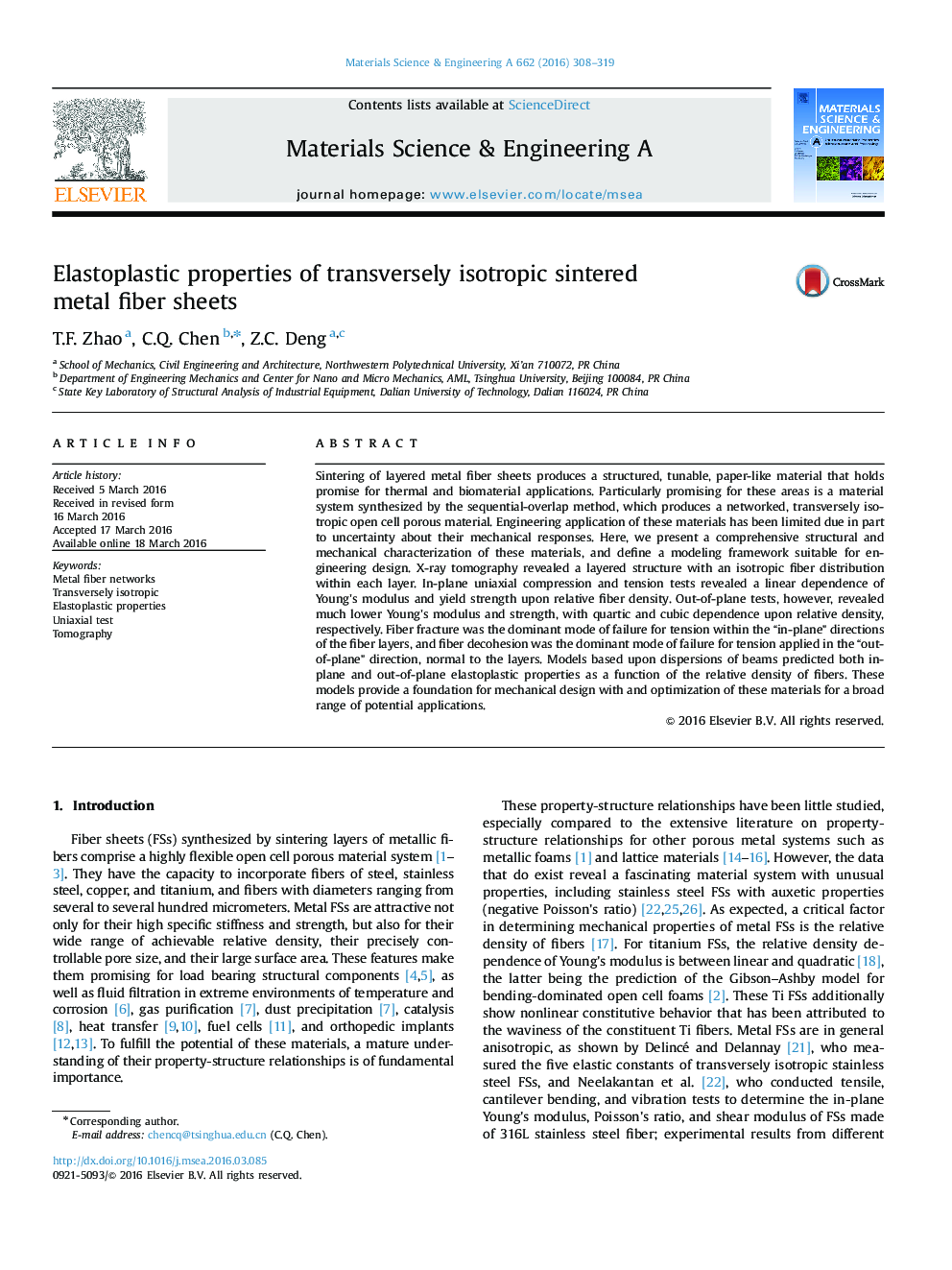| کد مقاله | کد نشریه | سال انتشار | مقاله انگلیسی | نسخه تمام متن |
|---|---|---|---|---|
| 1573465 | 1514681 | 2016 | 12 صفحه PDF | دانلود رایگان |
عنوان انگلیسی مقاله ISI
Elastoplastic properties of transversely isotropic sintered metal fiber sheets
ترجمه فارسی عنوان
خواص الاستوپلاستی ورق های فلزی فلز متخلخل ایزوتروپیک
دانلود مقاله + سفارش ترجمه
دانلود مقاله ISI انگلیسی
رایگان برای ایرانیان
کلمات کلیدی
ترجمه چکیده
پخته شدن ورقه های فلزی لایه ای فلزی، یک ماده ساختاری، قابل تنظیم و کاغذی را تولید می کند که وعده هایی برای کاربردهای حرارتی و بیومواد دارد. به ویژه برای این مناطق امیدوارم یک سیستم مادی است که با روش پیروی از همپوشانی ترکیب شده است، که مواد متخلخل سلولی باز، متشکل از مقطع عرضی، ایزوتروپیک را ایجاد می کند. کاربرد مهندسی این مواد محدود به دلیل عدم اطمینان در مورد واکنش های مکانیکی آن است. در اینجا، ما مشخصات کلی ساختاری و مکانیکی این مواد را ارائه می دهیم و یک چارچوب مدل سازی مناسب برای طراحی مهندسی را تعریف می کنیم. توموگرافی اشعه ایکس یک ساختار لایه ای با توزیع فیبر ایزوتروپیک در هر لایه نشان داد. تست های فشرده سازی و کشش یکسانی درون هواپیما، وابستگی خطی مدول یانگ و استحکام کششی را بر روی تراکم نسبی فیبر نشان داد. با این حال، آزمایش خارج از هواپیما نشان داد که مدول و قدرت یانگ پایین کمتر است و وابستگی کوارتتی و مکعب به تراکم نسبی بیشتر است. شکست فیبر، حالت غالب شکست در تنش در داخل یک هواپیما بود؟ جهت لایه های فیبر و لایه های لایه ای فیبرها، حالت غالب شکست در تنش در فضای خارجی بود؟ جهت، عادی به لایه ها. مدل های مبتنی بر پراکندگی پرتوها هر دو خواص الاستوپلاستی در داخل هواپیما و خارج از هوا را به عنوان تابعی از تراکم نسبی الیاف پیش بینی می کنند. این مدل ها پایه ای برای طراحی مکانیکی و بهینه سازی این مواد برای طیف گسترده ای از کاربردهای بالقوه فراهم می کند.
موضوعات مرتبط
مهندسی و علوم پایه
مهندسی مواد
دانش مواد (عمومی)
چکیده انگلیسی
Sintering of layered metal fiber sheets produces a structured, tunable, paper-like material that holds promise for thermal and biomaterial applications. Particularly promising for these areas is a material system synthesized by the sequential-overlap method, which produces a networked, transversely isotropic open cell porous material. Engineering application of these materials has been limited due in part to uncertainty about their mechanical responses. Here, we present a comprehensive structural and mechanical characterization of these materials, and define a modeling framework suitable for engineering design. X-ray tomography revealed a layered structure with an isotropic fiber distribution within each layer. In-plane uniaxial compression and tension tests revealed a linear dependence of Young's modulus and yield strength upon relative fiber density. Out-of-plane tests, however, revealed much lower Young's modulus and strength, with quartic and cubic dependence upon relative density, respectively. Fiber fracture was the dominant mode of failure for tension within the “in-plane” directions of the fiber layers, and fiber decohesion was the dominant mode of failure for tension applied in the “out-of-plane” direction, normal to the layers. Models based upon dispersions of beams predicted both in-plane and out-of-plane elastoplastic properties as a function of the relative density of fibers. These models provide a foundation for mechanical design with and optimization of these materials for a broad range of potential applications.
ناشر
Database: Elsevier - ScienceDirect (ساینس دایرکت)
Journal: Materials Science and Engineering: A - Volume 662, 26 April 2016, Pages 308-319
Journal: Materials Science and Engineering: A - Volume 662, 26 April 2016, Pages 308-319
نویسندگان
T.F. Zhao, C.Q. Chen, Z.C. Deng,
